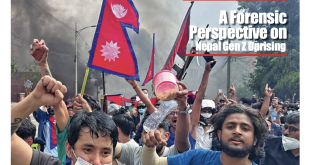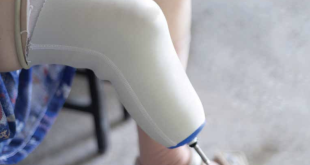 I’m a bit puzzled myself as to why the mortality rate due to COVID-19 is significantly lower in our country compared to other parts of the world.”
I’m a bit puzzled myself as to why the mortality rate due to COVID-19 is significantly lower in our country compared to other parts of the world.”
Dr. Bipin Nepal, transfusion medicine expert, has over 10 years of experience in clinical and research medicine and has been working at different pioneering research projects, including introducing convalescent plasma therapy in this pandemic, which saved many COVID-19 patients.
What is the current scenario of transfusion medicine in Nepal?
Nepal lags far behind in the field of transfusion medicine from the rest of the world. Despite many advances in different medical disciplines, transfusion medicine is still traditionally practiced in our country. The scope of transfusion medicine is very high, but the knowledge even among doctors, healthcare workers, and policy makers is limited to collecting blood, blood grouping, cross matching, and issuing. Transfusion medicine is a vast and upcoming subject that has both diagnostic and therapeutic modalities like immune hematology, plasma exchange, red cell exchange, intrauterine transfusions, cellular therapies, and stem cell transplants. The government’s initiative in this field is, however, too little and very few trainings have been offered in blood transfusion in the country.
On paper, there has to be a specialist in transfusion medicine in the government body, central blood transfusion service, and in major hospitals and blood banks, but in practice, there has been no place for even only one specialist in the whole country. From this, we can assume the lack of apathy in this field from the governing body and policy makers. The main hurdles in transfusion medicine are manpower, equipment, and technical expertise. Even doctors and paramedics are unaware of the rational use of blood and blood products, due to which, blood has been used and managed randomly and rampantly at transfusion centers.
Due to mismanagement of the authorities, blood banks, and hospitals, and lack of awareness and expertise, blood demand and supply is hardly met in Nepal. From one whole blood, at least three components can be made, and at least three patients can be benefitted, but most of the blood banks don’t make these components. Therefore, we need significant improvements in knowledge and skills in the field of transfusion medicine. We need to develop and train blood bank staffs, technicians, paramedics, and doctors, and finally, upgrade equipments. There are about 105 transfusion centers across the country, but 95 % lacks, and very few transfusion centers, including Grande Hospital Transfusion Centre, are doing new things in the field, from research work to making medicines from blood.
What are the complications associated with blood transfusion practices? What are the major contributing factors for human errors?
There are two major complications: acute and delayed. Acute complications occur due to incompatible transfusion leading to acute haemolytic reaction (AHTR), febrile reaction, allergic reactions, and anaphylactic reactions. Other acute complications are transfusion-related acute lung injury (TRALI), circulatory overload, and bacterial contamination. The delayed complications include alloimmunization, graft versus host disease, transfusion-transmitted infections, and late hemolytic reaction, such as hemolysis, which occurs when a recipient receives the incorrect blood product, leading to drop in blood count and hemoglobin levels.
Not having proper knowledge and training, and not updating standard operating procedure, poses the biggest risk for human errors. The main clerical errors start from the lab, with unlabeled samples, mismatched blood samples, inability to identify blood groups, misinterpretations, and not having good equipment. For example, there are more than 500 different types of blood group systems, of which 50 are the most important, but we only follow two blood group systems, such as ABO an Rh in Nepal, which can contribute to clerical errors.
Do we have a standard protocol or guidelines on blood transfusion?
The government established the National Bureau for Blood Transfusion Service (NBBTS) in 2014/2015 and it developed a revised protocol and policies for regulating blood transfusion in the country. Ironically, we don’t know why transfusion medicine specialists’ contribution is not needed there in making polices and guidelines. So, we can’t say we don’t have a protocol or guidelines, but it is not updated on the new standard. Very few centers follow the standard protocols, and it is very difficult to say that all transfusion centers follow the same kind of guidelines at all.
In Nepal, we are still continuing whole blood transfusion? What do you have to say about this?
We do have machines to separate blood components at about 30 different transfusion centers across the country, but they are barely separating 20-30 percent of whole blood. Using whole blood leads to misuse of resources. It is also not economical, and it could further harm patients. But, we are still using whole blood in Nepal. It is mainly due to lack of trained manpower in the transfusion medicine and lack of technical expertise in the field. In developed countries, whole blood transfusion has become obsolete and is no longer recommended except for some reason, as we can separate the whole blood into three components: red blood cells, plasma, and platelets, and they can be used to treat three different patients.
You’ve treated many COVID-19 patients with convalescent plasma therapy during the pandemic, can you tell us more about this treatment and how beneficial it was to patients?
We took the initiative for convalescent plasma therapy in July 2020. Though we had been nudging the government about treatment with convalescent plasma months before than that, it was just under process. So, we started the procedure even with a risk at that time, which later was under the clinical trial of Nepal Health Research Council. Till date, more than1500 people have taken this treatment, and the clinical trial showed good results in many patients.
Convalescent plasma therapy uses plasma from recovered patients to help others recover. When a pathogen invades our body, the immune system in our body starts making antibodies to fight off the invader. In the case of COVID-19, our body makes antibodies against COVID-19. And, even after one has recovered, the antibodies will remain in his plasma for a certain time. When we use this plasma in people infected with COVID-19, it will neutralize the COVID infection in their body and help them to recover faster.
Convalescent plasma therapy has a long history of more than 100 years. It has been used to treat mumps, measles, Spanish influenza, and many other diseases. We used the same treatment in a clinical trials to treat COVID patients until other medicines and vaccines were available. In Nepal’s case, this treatment was proved to be beneficial.
How safe and effective is convalescent plasma therapy in treating people with COVID-19?
The treatment has shown different results worldwide. Different countries doing trial showed different results, ranging from not beneficial to somewhat beneficial, but in Nepal, the result was satisfactory. The research conducted by Nepal Health Research Council (NHRC) showed that about 39 percent of patients benefitted when treated alone with convalescent plasma.
How was the recovery of people who were treated with convalescent plasma therapy in your hospital, were there any adverse effects?
Of the total patients who received convalescent plasma during the trial period, 39 percent recovered, and adverse effects were reported in less than 2 percent. They were mostly allergic reactions. There were no any significant complications like hemolytic reactions. Most were minor reactions.
What would you like the government to do to support your work in blood transfusion?
The main challenge in transfusion medicine is manpower. We have very few people working in this field. The government should assign more people who can teach and train people in transfusion medicine. The government should motivate more people to study transfusion medicine, as this is a multidisciplinary field, and it is needed in all aspects of healthcare. Currently, the situation is that, the government and the authorities cannot even adjust a single transfusion medicine expert in the country, and the transfusion related work is done by experts in other fields. We talk about liver transplants and about other progress in the medical field, but we lack talking about the backbone; our transfusion medicine still has a long way to go. So, the government needs to take initiative and use the expertise of people who are already working in this field and allocate and train more people for the development of transfusion medicine in the country.
Considering that there has been only about 0.5% mortality due to COVID-19 in Nepal, would you agree that Nepal’s health system has coped very well, as compared to even developed countries like the UK and the USA?
I’m a bit puzzled myself as to why the mortality rate due to COVID-19 is significantly lower in our country compared to other parts of the world. While the cases are still rising in India, the infection seems to be pretty much contained here till date. I think the healthcare system of Nepal did what it could under the given circumstances and with its limited resources to manage the pandemic, but I also feel that it should have done more and have to do more as the pandemic hasn’t ended yet.
 Medicosnext
Medicosnext




